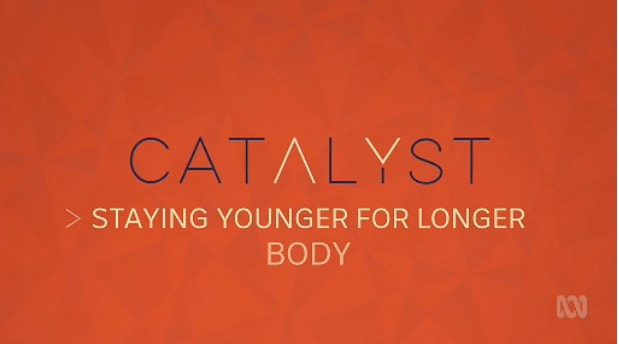|
SEARCH My Blog (Opens in new tab)
Last week ABC TV (Australia) ran a program on their Catalyst series of science programs revealing how we can all "improve our healthspan by making simple changes to the way we live our lives" (watch or download the program here).
The show featured retired newsreader Ian Henderson on a quest to find "the secrets of ageing healthily" - a subject close to my heart. I must say that as someone well-versed in the "secrets" I heard only one new one, which I'll explore below. But it is fantastic to see these ideas put out into the mainstream and made more accessible to everyone. I enjoyed his discoveries and his enthusiasm, and the more of these kind of practical education shows the better.
I'll summarise his key findings here, accompanied by my own insights in also discovering and applying these things over the last 20 years. That might help fast-track you to picking up on those which appeal to you most and also those which give you the most bang for your exercise buck.
Below are the "non controversial" secrets he discovered. Then I will discuss the diet discoveries as that's where things became a little more confusing:
I've quoted below the most significant comment in the entire program - because this is not well known. This role of mitochondria is one the fundamental reasons that attention to building strength and stamina are essential to living longer better, and, in fact, managing diseases like Type 2 Diabetes. I worked this out after I was diagnosed with T2D in 2000 - which was the fright which actually kicked off my 20 year path to better health and fitness.
The intense exercise puts my body through a brief moment of stress, and that amplified chemical reactions inside my cells, which repair and rejuvenate vital structures called Mitochondria. Mitochondria act like power plants, converting the food you eat into energy, and their ability to do this declines as we get older. But intense exercise like this has been shown to help stop or even reverse this decline and help fight ageing. ...pushing yourself to this intensity may not be for everyone. But older people who are able to manage high intensity training have been found to get a 69% increase in the capacity of their mitochondria.
Now, moving on to the diet segments - this is where things became a little more confusing, even for me.
Diet distractions - which, what, when?
The show discussed two different diet "discoveries".
Restricted calories The first came from Professor Luigi Fontana who advocates that the "right diet" is to not keep your metabolism running at full speed. Eating fully constantly produces a lot of waste products and accumulates metabolic and cellular waste which ages us. Prof Fontana recommends putting our bodies into "maintenance mode" a couple of days a week, which accelerates repair. He recommends that for 2 days each week we eat only non-starchy vegetables - as much as we want - along with generous dabs of olive oil. That makes sense to me as it follows the same principles as the many fasting diet variations, and is an easier option. If you like this option then my recommendation is to go further than avoiding starchy vegetables and to include more resistant starch foods.
Don't restrict calories but eat less protein
In the final segment of the program Professor Steve Simpson and Dr Sam Solon-Biet from the University of Sydney discussed their research on varying our macronutrient balance as we age. Their hypothesis is that the ratio of protein to carbohydrates in our diet changes the rate of ageing. They also wanted to examine the possibility of continuing to "eat normally" without having to impose periods of calorie restriction e.g. the fasting methods of Professor Fontana mentioned above.
In a nutshell, they advocate that eating a lower ratio of protein to carbohydrate as we age will slow down the rate of ageing. So firstly in the program it was recommended that we fast, or eat a lot less, for 2 days, and then it was recommended that we don't impose calorie restrictions but eat less protein as we age. Here we have the classic problems of conflicting information and too much information - which inevitably leads to people doing nothing. My recommendations for taking action
Here is what I recommend if you want to start now and take action, based on my experience of the last 20 years of learning how to lower my body age (plus I'll call on my Professional Diploma in Sports Nutrition):
I believe that we actually need a higher ratio of protein as we age, not least because we become less efficient at utilising protein as our metabolic processes rust. I aim for around 2.2g / kg each day, and that is a young athlete's usual target and represents around 25% of daily energy intake (depending on your activity level). Then add in your carbohydrate requirements, and the residual daily energy requirements from fat - good fats. My preferred ratio is about 25% protein, 50% carbs, and 25% fat - with more carbs if you are doing intensive exercise. (If you prefer Professor Simson's advice and you are over 60 then you would adjust this to 15% protein or less, 65% carbs, and 25% fat.) Don't sweat the details - start small and progress
But here's the bottom line - these details don't matter too much for the first 1 or 2 years of starting to eat and exercise more healthily.
In that time you need to be resetting your overall nutrition to improve its quality and reducing its volume (for most people) - based on the standard guidelines. You need to be making exercise part of your daily lifestyle, and learning to become more body-aware. Attempting to change too much too soon inevitably results in you giving up, as it becomes all too hard.
Watch the show, pick those things that motivate you and will get you started on a new routine of nutrition and fitness, and then fine-tune little-by-little each three months to improve your potential outcomes.
The most important thing is to start, and to limit your initial ambitions to what you know you can do consistently and turn into a habit. The hardest thing is to know how to start, and the show gives some good tips. Good luck. Latest: get your free customised fitness plan designed uniquely for you.
|
ChoicesSince I was diagnosed at 50 with Type 2 diabetes I've been learning how to do bone-building fitness training which lowers my age. You can too. It's your choice. Walter Categories
All
Archives
May 2023
|

 RSS Feed
RSS Feed



